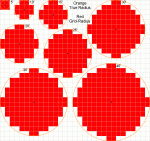Ancalagon
Dusty Dragon
Hmmm.
If the bad guy was between two heroes who are in a diagonal, it would be quite possible to do this with the corner of the cube without having to resort to the "point" of a diamond. So it's legitimate imo. On the other hand, it makes it harder to adjucate so it slows down the game. What is more important to you?
If the bad guy was between two heroes who are in a diagonal, it would be quite possible to do this with the corner of the cube without having to resort to the "point" of a diamond. So it's legitimate imo. On the other hand, it makes it harder to adjucate so it slows down the game. What is more important to you?

